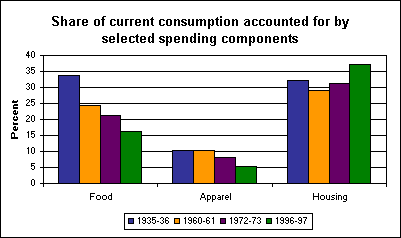An official website of the United States government
 United States Department of Labor
United States Department of Labor
Since the mid 1930s, the U.S. economy has been affected by wars, economic depressions and booms, technology advances, changes in the labor force, and changes in population demographics. These factors, as well as changes in consumer tastes and preferences, have influenced consumer spending habits.

[Chart data—TXT]
In 1935-36, over one third of total spending was allocated to food, making food expenditures the largest portion of total spending. The share of spending on food has consistently dropped, falling to less than half the 1935-36 value by 1996-97. Like food shares, spending allocated to apparel and related services has decreased over time, accounting for about 1 in every 10 dollars in 1935-36 and dropping to 1 in every 20 dollars in 1996-97.
Unlike the decreasing shares allocated to food and clothing, the share spent on housing has fluctuated, with the 1960-61 period representing the low of just under 30 percent and the 1996-97 period representing the high of over 37 percent. Housing replaced food as the largest portion of total spending by 1960-61.
These data are a product of the BLS Consumer Expenditure Survey program. Additional information is available from "Consumer Expenditure Survey: Quarterly Data from the Interview Survey, Third Quarter 1997: Historical Spending Patterns," BLS Report 932.
Bureau of Labor Statistics, U.S. Department of Labor, The Economics Daily, Food, clothing, and shelter see different historical spending patterns at https://www.bls.gov/opub/ted/1999/sept/wk1/art02.htm (visited May 23, 2024).

